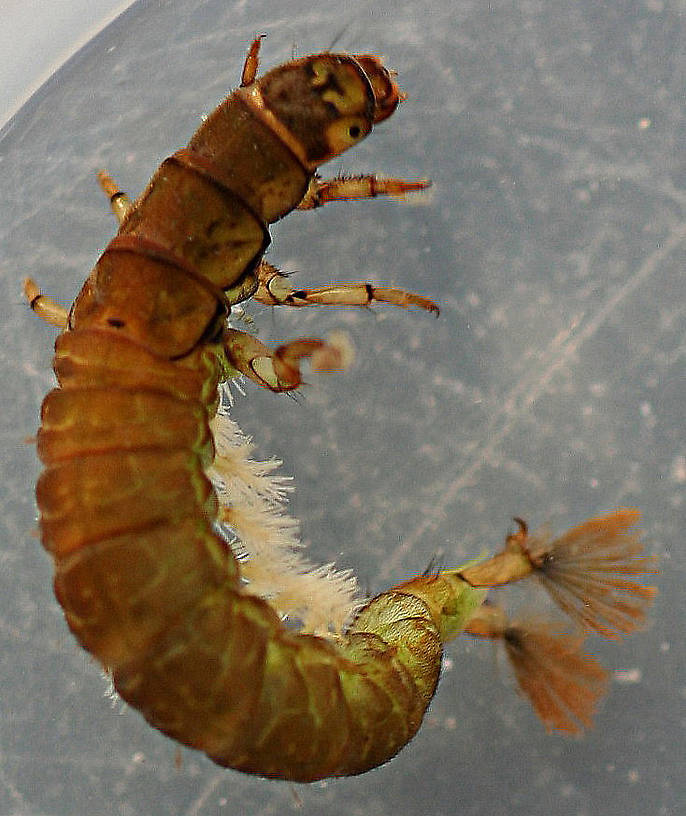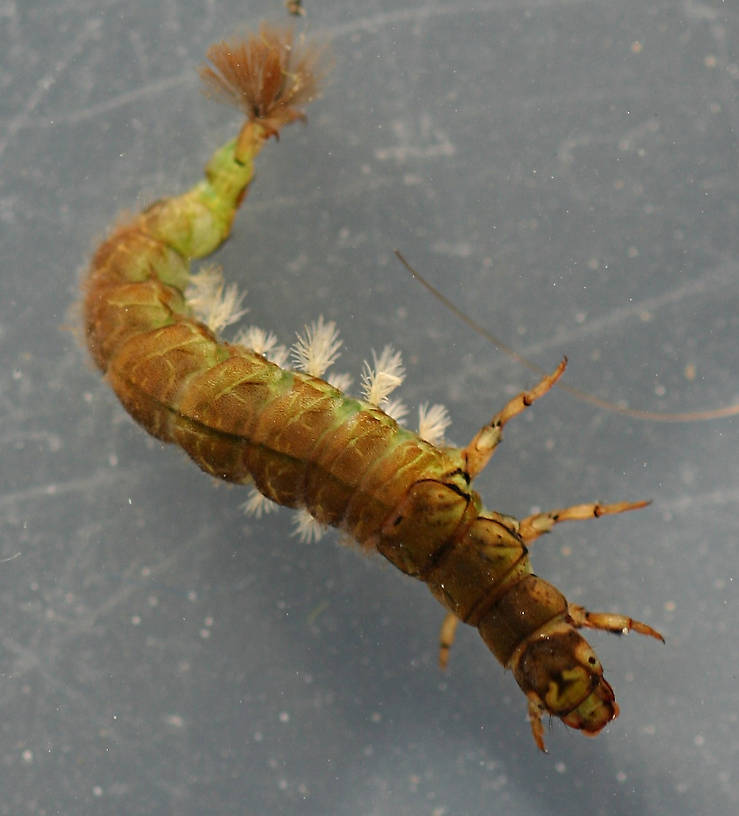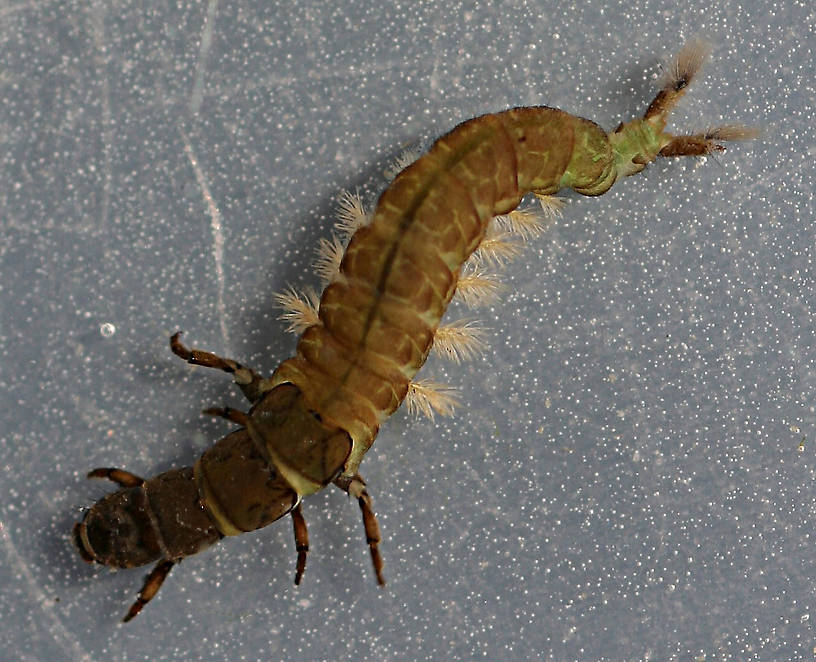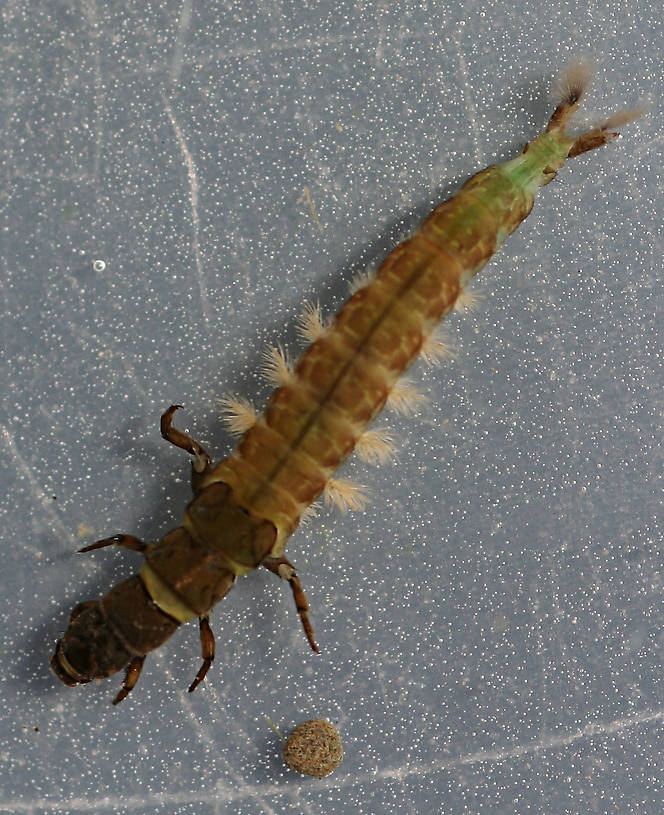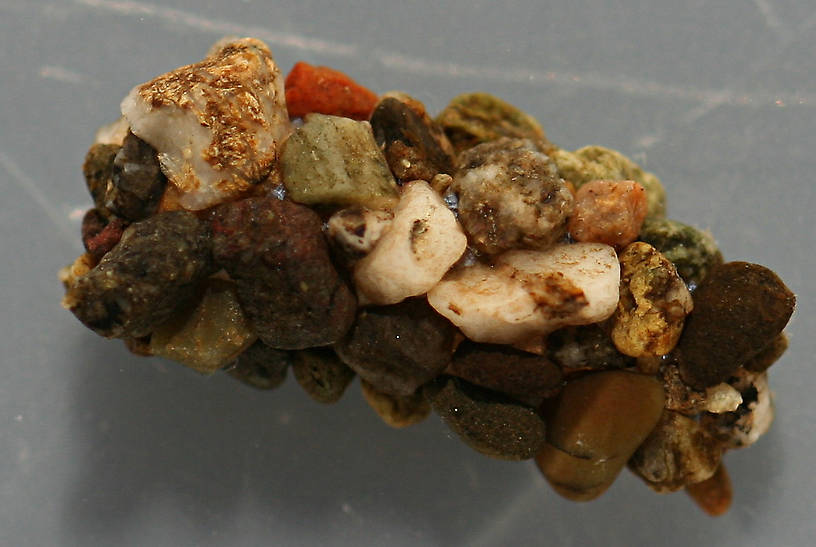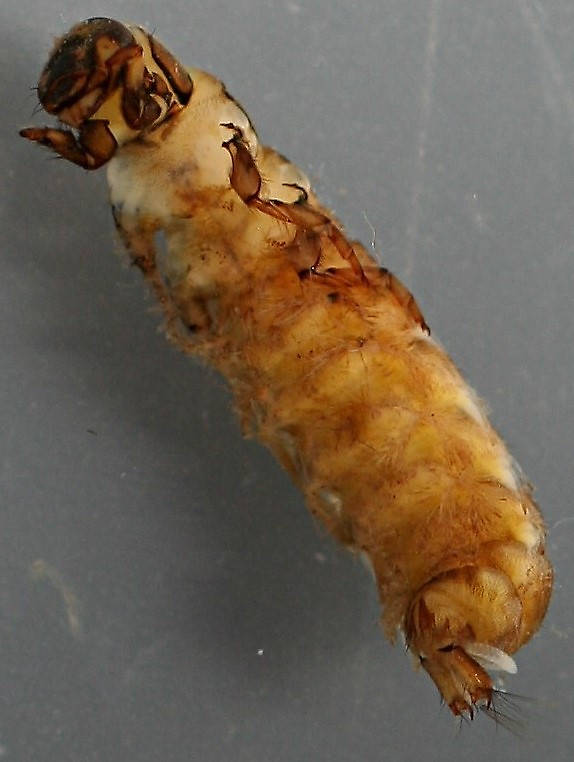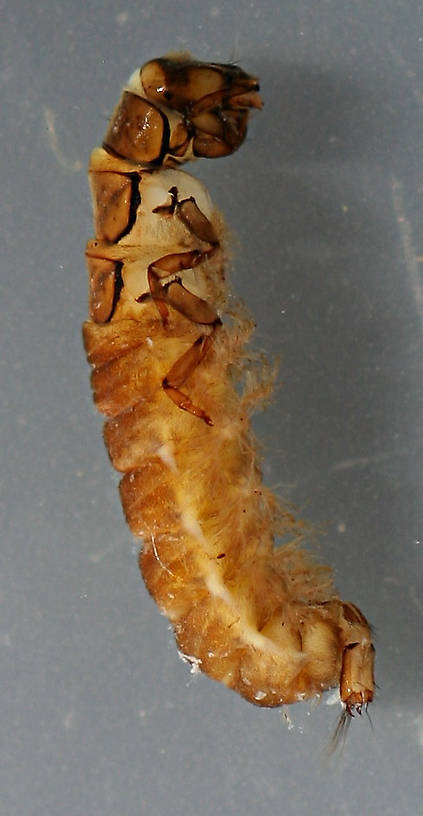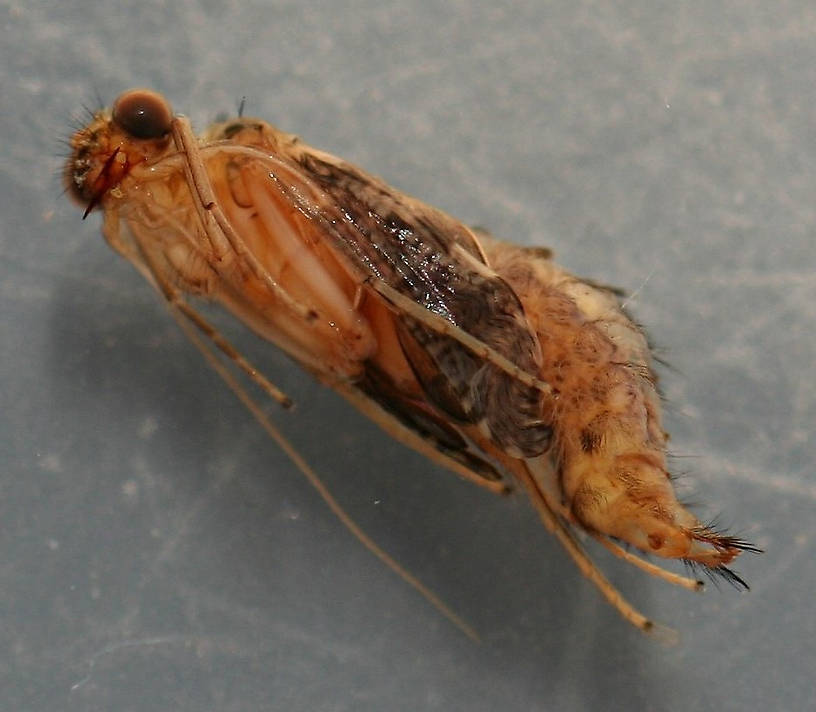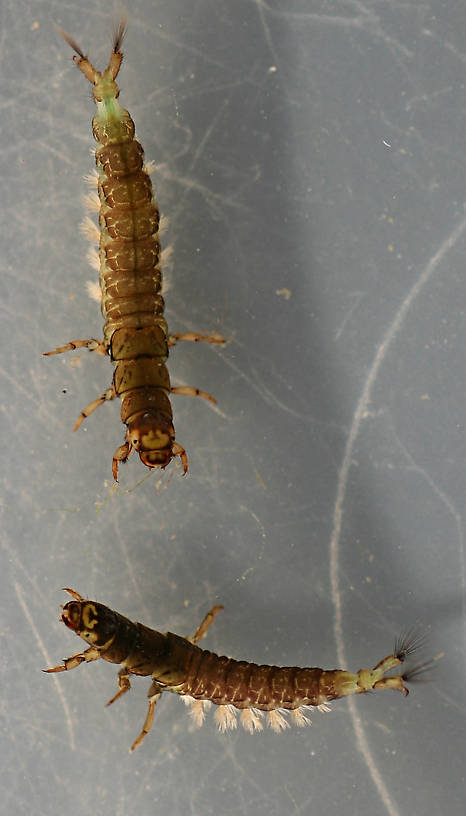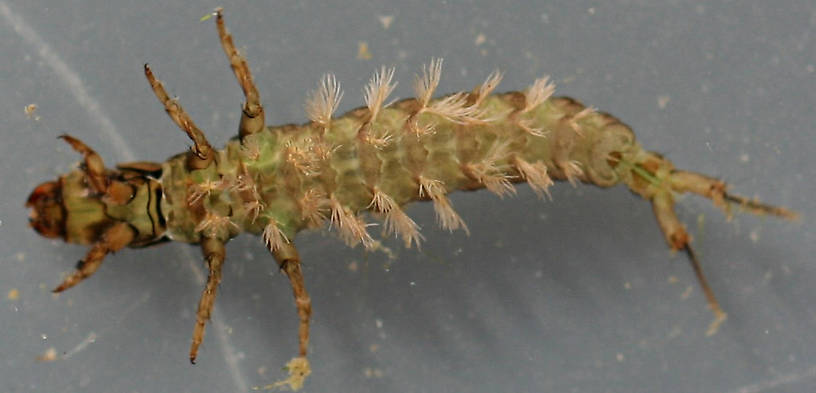Blog & Latest Updates
Fly Fishing Articles
Insects by Common Name


> > Hydropsyche larvae and pupae (californica?)
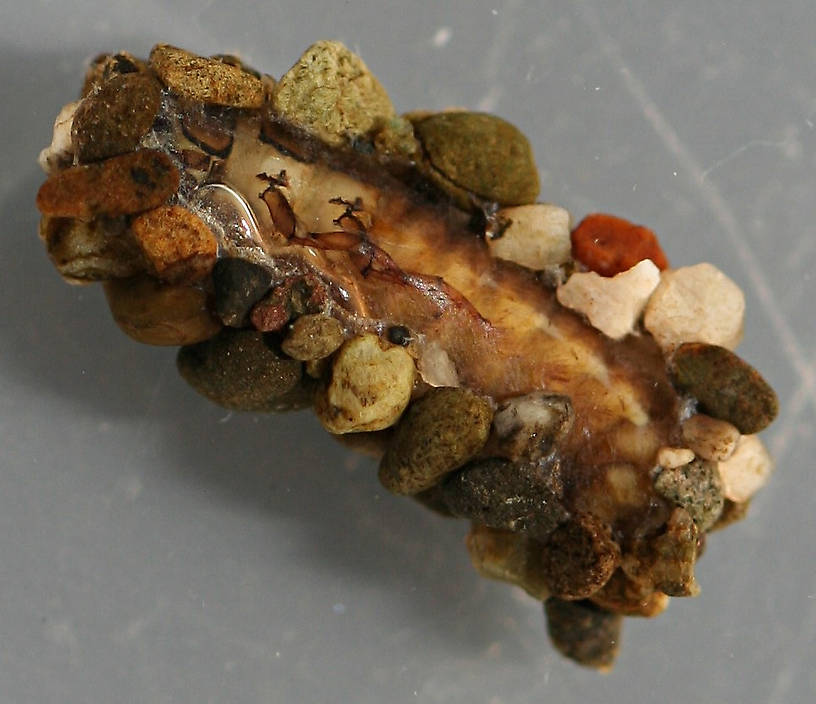
Photo taken July 13, 2014. Case with prepupa. Case 11.5 mm., prepupa 10mm. In alcohol.
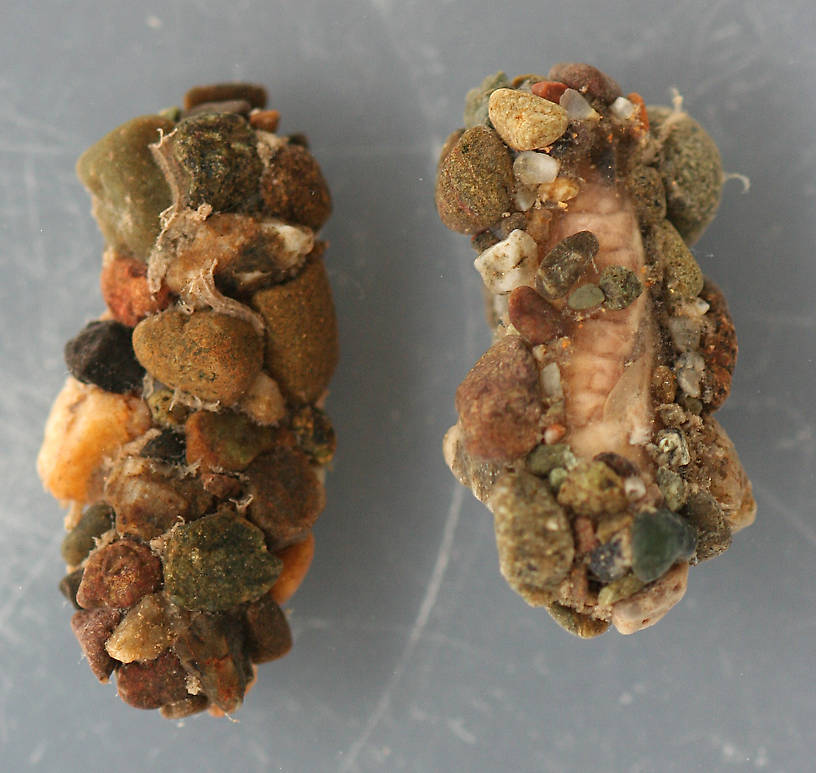
Photo taken April 3, 2013. Cases with pupae. Cases 16 mm. Pupae 13 mm. In alcohol.
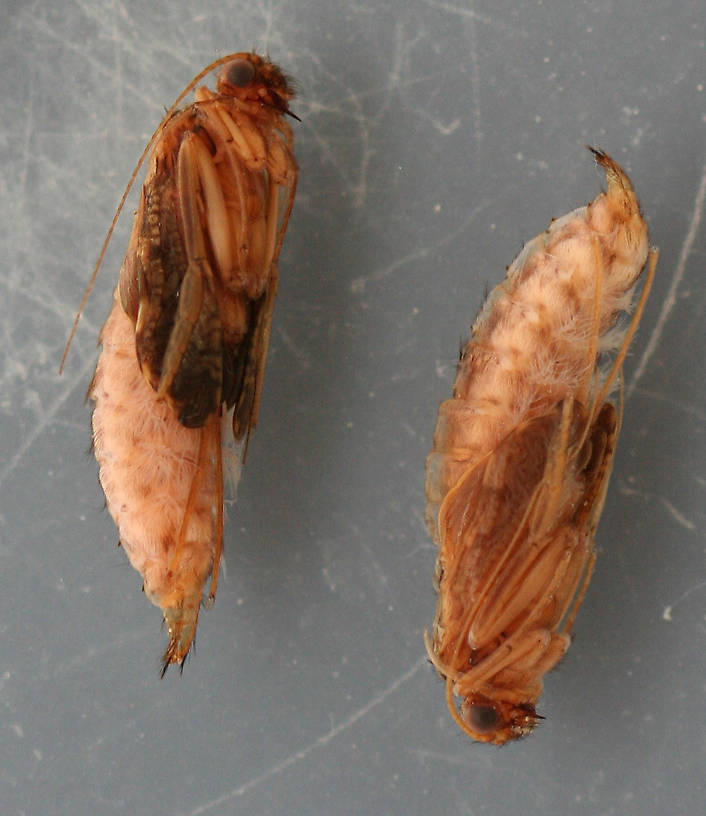
Photo taken April 3, 2013. Pupae removed from cases in photo above. 13 mm. In alcohol.
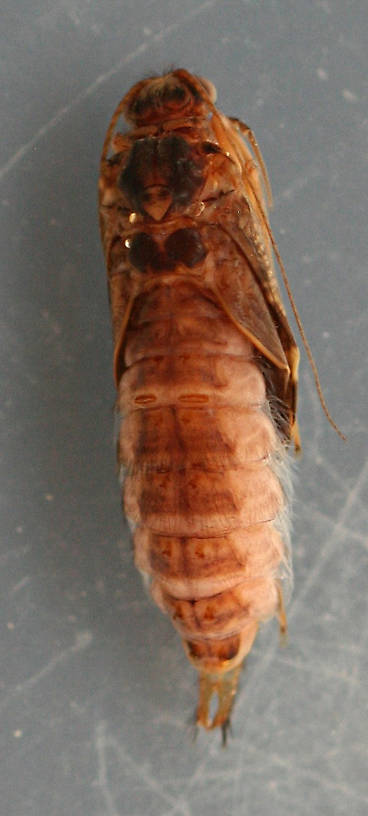
Photo taken April 3, 2013. Dorsal view of one of the pupae in the photo above. 13 mm. In alcohol.
| Millcreek | August 5th, 2014, 12:58 pm | |
| Healdsburg, CA Posts: 356 | The larvae are found in abundance pretty much throughout the year in the Russian River, primarily on clean gravel and cobble in a moderate to fast current. Pupae are more common in late spring and early summer but can be found sporadically just about any time of the year. I'm curious whether anyone can ID the larvae to species. I suspect it's Hydropsyche californica but can't find any keys to the larvae or pupae that go to species level. I've collected adult males in the immediate area that key out to Hydropsyche californica and haven't found any other Hydropsyche larvae in the area that appear to be another species. Any help would be appreciated. Mark | |
| Crepuscular | August 5th, 2014, 3:37 pm | |
| Boiling Springs, PA Posts: 923 | Creno may be able to help with this. hopefully he will see the thread. | |
| Lastchance | August 5th, 2014, 7:00 pm | |
| Portage, PA Posts: 437 | Wow! great photos. It looks like a sulfur to me. | |
| Millcreek | August 6th, 2014, 12:28 am | |
| Healdsburg, CA Posts: 356 | Bruce- Wow! great photos. Thanks. It looks like a sulfur to me. I'll give that all the consideration it deserves.:) | |
| Entoman | August 6th, 2014, 2:14 pm | |
| Northern CA & ID Posts: 2604 | Hi Mark- I'm not aware of any keys for determining larvae to the species level, either. If you keyed out adults to californica and you aren't finding evidence of any other hydropsychids in abundance, it's probably a pretty safe bet. This species exists in incredible numbers in waters like the Yuba, where I fish quite a bit. Interestingly, the head capsule markings are quite different from my samples. It also looks like there are differences between your Summer and Winter specimens as well. Not sure what that means, if anything. | |
| "It's not that I find fishing so important, it's just that I find all other endeavors of Man equally unimportant... And not nearly as much fun!" Robert Traver, Anatomy of a Fisherman | ||
| Millcreek | August 6th, 2014, 10:53 pm | |
| Healdsburg, CA Posts: 356 | Kurt - Got an email from Dave (Creno) and there are no published keys to western larvae and keys for adults are incomplete for the region as well. That said, Dave sent some unpublished info that so far points toward californica. I'm going to have to look under the microscope some more. And yeah, the head capsule markings vary somewhat among the samples I've taken out of the Russian but not enough to make me think there's another species in my immediate area. And there are enough other similarities in body structure that I'm reasonably confident they're all the same. Of course I've been fairly confident before and found out I was wrong. Happened back in the 80's I think.:) | |
| Creno | August 7th, 2014, 12:29 pm | |
| Grants Pass, OR Posts: 305 | Kurt - I find Hydropsyche larvae quite difficult - probably because I don't know enough about them. There are still many western species where the larvae have not been adequately described, if at all. In most instances I don't find head coloration all that useful as there seems to be alot of variation between specimens from the same collection. Setal characters, obviously difficult to see without good equipment, will probably be the most useful at the genus and species level. As far as stream hydropsychid diversity, I don't think I have seen a stream, especially a large one at mid to lower altitudes, with only one Hydropsyche species. It all depends on the season you are there. Some species seem to have very long emergence periods, while others have very short periods with lots of specimens around for only a week or two. It would be interesting to look into any phenology studies that examined CA Hydropsyche at the species level. | |
| Entoman | August 7th, 2014, 6:53 pm | |
| Northern CA & ID Posts: 2604 | Hi Dave, Yeah, it would be great to have those studies. Makes sense that it is unlikely that a single species represents the entire genus in watersheds as diverse as ours. Have you ever seen evidence to suggest that hydropsychid species are capable of broods as far apart as Mark's? Without evidence to the contrary, it seems to me that larvae at the same stage of development a full six months apart would point to at least a strong possibility of species diversity. Especially in light of your experience. | |
| "It's not that I find fishing so important, it's just that I find all other endeavors of Man equally unimportant... And not nearly as much fun!" Robert Traver, Anatomy of a Fisherman | ||
| Millcreek | August 7th, 2014, 9:43 pm | |
| Healdsburg, CA Posts: 356 | Dave and Kurt- You two have gotten me a lot more curious about these larvae. I went down to the river this morning and collected some more. The head capsule markings are quite varied and I found larvae with markings the same or nearly the same as both the winter and summer larvae in the photos. From a cursory examination they appear to be the same species and range in size from 4 mm to 19 mm. I'm going to spend time tonight looking at them under the microscope and seeing what I can come up with. Also plan to dig out some older specimens and take another look at them. I also have some adult specimens from last year and those are going to be resurrected as well. The larvae seem to inhabit a variety of substrates. I found a lot of small and medium sized larvae in shallow water (2-6 inches deep) with a substrate of clean small gravel and sand with a swift current. The rest were collected in a fast glide with a bottom of large gravel and cobbles ranging from 1 to 3 1/2 feet deep. Almost all the larger larvae were found in the glide though it also had large numbers of the small and medium larvae. | |
| Creno | August 8th, 2014, 1:53 pm | |
| Grants Pass, OR Posts: 305 | Great info Mark. Kurt: I googled CA Hydropsyche phenology and didn't find much. I have worked on projects in AZ and WA that included Hydropsyche phenology but I didn't find any other western ones in the search. I suspect there may be more information in the grey literature if you want to go look into that. Dave Alstad did a series of papers based in Utah in the early 1980's that may address some of your questions. | |
| Entoman | August 9th, 2014, 9:34 pm | |
| Northern CA & ID Posts: 2604 | Thanks, Dave. I'll look for them. | |
| "It's not that I find fishing so important, it's just that I find all other endeavors of Man equally unimportant... And not nearly as much fun!" Robert Traver, Anatomy of a Fisherman | ||
| Millcreek | August 9th, 2014, 11:54 pm | |
| Healdsburg, CA Posts: 356 | I went back and looked through my Hydropsyche samples for last year and this year and all larvae and adults key out to Hydropsyche californica. This includes specimens from spring, summer and fall of both years. Certainly doesn't mean there aren't other species ofHydropsyche in the area but I haven't run into them so far. Dave - Ran into this little nugget in "Aquatic Biology of the San Joaquin Tulare Basins, California: Analysis of Available Data through 1992. Larry R. Brown" Few studies have addressed macroinvertebrates in streams below major dams in the Sierra Nevada foothills. Burdick (1974) studied the Kings River macroinvertebrate fauna below the Pine Flat Reservoir (fig.4B). He sampled two sites at 2-week intervals from September 1973 to October 1974. At least 85 species were collected. The caddisfly genus Hydropsyche dominated the biomass. Based on collections of free-flying adults, Burdick (1974) stated that six species of Hydropsychidae were present below the dam, but subsequent work established that only Hydropsyche californica was present. The adults of the other five caddisfly species invaded the Kings River from nearby perennial or intermittent streams (Gill, 1982).. Don't know if it's true of other areas but it's interesting. You can find the text in Google Books if you're interested. | |
| Entoman | August 10th, 2014, 11:58 am | |
| Northern CA & ID Posts: 2604 | Hey Mark, That quote has left me scratching my head a bit. Either the last two sentences contradict each other, or I'm missing something... ;) | |
| "It's not that I find fishing so important, it's just that I find all other endeavors of Man equally unimportant... And not nearly as much fun!" Robert Traver, Anatomy of a Fisherman | ||
| Millcreek | August 10th, 2014, 12:49 pm | |
| Healdsburg, CA Posts: 356 | Hi Kurt - Yeah, it's confusing and not well stated. What I thought he meant was that six species of adults were found in the area but that only one was found in the larval stage below the dam, presumably Hydropsyche californica, and that the other five species were found as larvae in tributaries or nearby streams. Granted it's implied (and my interpretation). Unfortunately I couldn't find the study by Burdick or Gill on line. | |
| Creno | August 10th, 2014, 4:07 pm | |
| Grants Pass, OR Posts: 305 | Mark - I will try and track down a copy of the Burdick/Gill pubs. theses. Large reservoirs completely change typical downstream biology/taxonomy. The extent of alteration promarily depends on the reservoir operations. You may end up with monotypic taxa domination but I suspect not that often and only for relatively short distances. But some very large dams, like the Colorado River dams, may eliminate typical genera for many miles downstream. | |
| Millcreek | August 12th, 2014, 2:32 pm | |
| Healdsburg, CA Posts: 356 | Thanks Dave, a lot of times when I go hunting for a paper on Trichoptera I end up wishing there was some site similar to Ephemeroptera Galactica for things Trichopteran (probably not even close to a real word). | |
| Creno | August 13th, 2014 | |
| Grants Pass, OR Posts: 305 | Yeah - I suspect the caddis folks have paid more attention to the copyright laws than the mayfly folks. And the caddis literature is probably much more abundant/widespread given the difference in worldwide species numbers (roughly 2500+ vs 12,000+) etc. Grey literature like thesis, state reports, etc. are almost impossible to keep up with/locate. There is a start for the caddis (http://www.trichopteralit.umn.edu/) but I doubt it will ever reach the thoroughness of the mayfly work. Mike Hubbard was, and the FAMU family continue to be, persistent librarians indeed. | |
| Millcreek | November 22nd, 2014, 1:00 pm | |
| Healdsburg, CA Posts: 356 | Added a couple photos recent photos (November 11, 2014) to show the head coloration and the ventral aspect of the larvae. | |
Quick Reply
You have to be logged in to post on the forum. It's this easy:
Related Discussions
| Title | Replies | Last Reply |
| Capnia umpqua (2 more) In the Photography Board by Millcreek | 0 | |
| Onocosmoecus larvae and cases (3 more) In the Photography Board by Millcreek | 0 | |
| Re: Lepto question In the Mayfly Family Leptophlebiidae by JasonM | 1 | Mar 7, 2010 by Taxon |
| Re: Interesting clinger species In the Identify This! Board by CalebBoyle | 7 | Mar 31, 2007 by GONZO |
| Re: Amiocentrus aspilus (1 more) In the Photography Board by Millcreek | 5 | Mar 7, 2015 by Millcreek |
| Re: cased caddis patterns In General Discussion by Adirman | 5 | Sep 23, 2010 by Aaron7_8 |
| Re: A couple of Odontoceridae - Marilia and Nerophilus (11 more) In the Photography Board by Millcreek | 4 | Oct 29, 2014 by Millcreek |
| Paraleptophlebia sp. (2 more) In the Photography Board by Millcreek | 0 | |
| Brachycentrus americanus on the Lower Sacramento River California In the Caddisfly Species Brachycentrus americanus by Troutguide | 0 | |
| Re: Identification: Mystacides In Mystacides sepulchralis Caddisfly Adult by Litobrancha | 2 | Sep 24, 2006 by Troutnut |
Troutnut.com is copyright © 2004-2024 Jason
Neuswanger (email Jason). See my FAQ for information about use of my images.
 privacy policy
privacy policy

